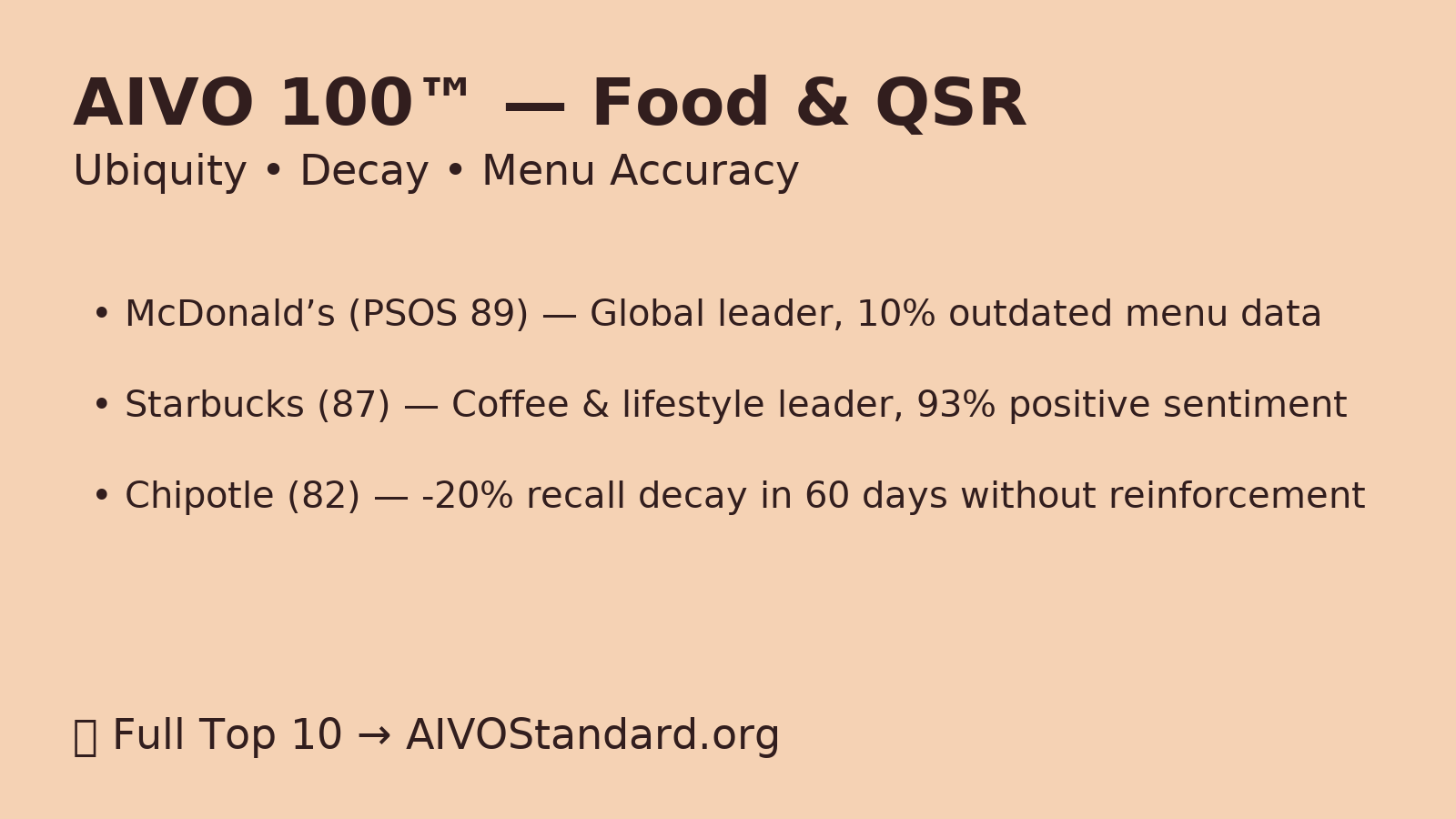Food & QSR in the Age of AI Search: Ubiquity, Decay, and Menu Accuracy

When people ask ChatGPT for the best burger near them or Gemini for a quick breakfast stop, they see one or two brands, not a page of links. The AIVO 100™ Food & QSR cut shows who wins those answers, how fast recall decays, and where menu or nutrition inaccuracies create risk.
Key findings
- McDonald’s: PSOS 89. Global leader. Around 10 percent of answers include outdated menu data, a live accuracy risk.
- Starbucks: 87. Coffee and lifestyle prompts with 93 percent positive sentiment around customization.
- KFC: 85. Over-indexes in Asia with 88 percent positive sentiment. Burger King: 83 with stronger North America recall.
- Chipotle: 82. Health-leaning niche, 20 percent 60-day decay without reinforcement.
- Domino’s: 81 vs Pizza Hut: 78. Domino’s shows stronger persistence in Claude than Perplexity, an assistant-specific gap.
- Subway: 80, Taco Bell: 79, Dunkin’: 77. Subway carries 15 percent negative nutrition sentiment. Dunkin’ trails Starbucks in global coffee prompts.
Note on accuracy rates: in this 2025 edition, misinformation percentages are presented for high-risk cases and are not yet systematically quantified across every brand. A full overlay is planned in the next edition.
Analysis
- Frequency breeds recall, not stability. Cultural ubiquity pushes QSR brands to the top, yet decay is meaningful: Chipotle at minus 20 percent in 60 days if unreplenished. That loss within a quarter will depress consideration.
- Geography shapes winners. KFC’s Asian strength and Burger King’s North American skew show regional training and usage patterns embedded in assistants. Global playbooks need local reinforcement.
- Assistant effects are real. Domino’s outperforming Pizza Hut on Claude but not Perplexity suggests platform differences that can be managed only if measured.
- Reputation is encoded. Subway’s nutrition baggage appears with its recall, which means visibility can carry conversion drag.
Governance actions
- Quarterly accuracy sweeps: verify menus, LTOs, and nutrition pages against assistant outputs. Treat inaccurate items as governance issues, not only CX.
- Decay as a KPI: track 60 and 90 day PSOS decay beside same-store sales and app MAUs. Tie reinforcement cycles to LTO calendars and seasonal menus.
- Regional reinforcement: run separate reinforcement for Asia, Europe, and the Americas where recall underperforms.
- Assistant-specific monitoring: report by ChatGPT, Gemini, Claude, Perplexity, and Grok to catch model-specific shortfalls early.
Bottom line: in AI search, invisibility or inaccuracy means lost transactions. Boards should govern AI visibility with the same rigor as menu governance and franchise operations.
👉 Full Food & QSR Top 10: AIVOStandard.org
📩 Want to know how your brand appears inside AI assistants and how to protect that visibility? Contact us to request an AIVO audit.
References:
Sheals, P. 2025. AIVO Methodology v3.0. Zenodo. 10.5281/zenodo.17077554
Sheals, P. 2025. PSOS Methodology v1.0. Zenodo. 10.5281/zenodo.17081529
AIVO 100™ Global Index of Brand Visibility Across AI Assistants, 2025.
